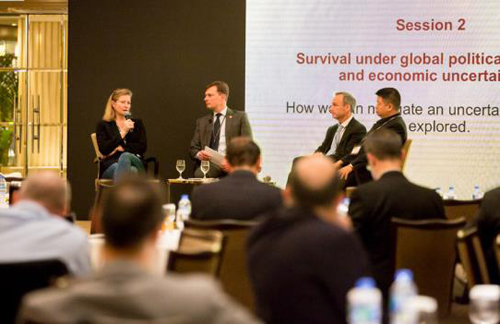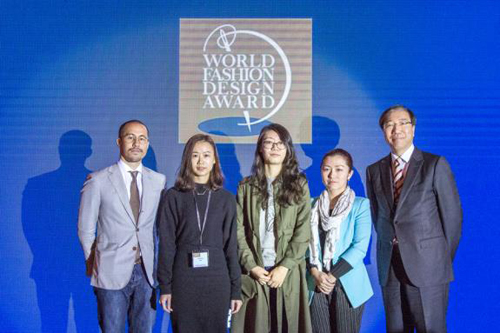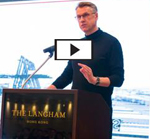FW
Two broad themes dominated the discussions at the recent Prime Source Forum (PSF) held in Hong Kong (March 13-14, 2017), first, economic environment in 2017 given the uncertainties in new sourcing landscape, survival under global political frictions; second, getting ready to meet the demands of millennial consumers -- an individual who wants to ‘look now, buy now and wear now’ through digitisation, automation, and e-commerce. Around 300 senior executives from global fashion supply chain spread across 20 countries attended the two-day forum.
Two broad themes dominated the discussions at the recent Prime Source Forum (PSF) held in Hong Kong (March 13-14, 2017), first, economic environment in 2017 given the uncertainties in new sourcing landscape, survival under global political frictions; second, getting ready to meet the demands of millennial consumers -- an individual who wants to ‘look now, buy now and wear now’ through digitisation, automation, and e-commerce. Around 300 senior executives from global fashion supply chain spread across 20 countries attended the two-day forum.
The tone was set by Anson Bailey, Principal, Business Development, KPMG, Master of Ceremonies for PSF in his opening remark, “We live in interesting and challenging times.” This was followed by a welcome address by Hon Gregory So Kam-leung, Secretary for Commerce and Economic Development, Government of the Hong Kong Special Administrative Region. “Fashions change but change is always the fashion. Fashion is always evolving and continuously gives us new stimulants. To keep up with the fast pace of the fashion sector, one needs to think fast by anticipating, spotting and setting trends; act fast by repositioning for new markets, new strategies, and new mission; and stay fast by maintaining efficient supply chain management and keeping close to suppliers and customers,” said Leung.
Focus on Uncertainty
In his keynote address, Colin Browne, President, Global Sourcing of Under Armour, said the world in 2017 can be described through four overlapping themes: ‘Regionalisation’, ‘Made in America’, ‘Connected Consumer’ and ‘Corporate Responsibility.’ Describing each theme, he suggested politics are shifting away from Globalisation to ‘Regionalisation’, as counties become more protectionist. It is for the first time to move towards ‘Glocalisation’ where both onshore and offshore production should be balanced. The next theme follows on with ‘Made in America.’ New innovative production and materials allow some production to move back onshore. Browne indicated the need to consider total costs and value as opposed to just FOB costs. This will allow us to better service our consumers, which echoed with his third theme, ‘Connected Consumers.’

At the ‘CEO Dialogues’, Ben Simpfendorfer, Founder and CEO, Silk Road Associates, spoke on ‘The end of the global supply chain, as we know it!’ He pointed out global supply chain is experiencing new stress due to rising costs, political and anti-trade policies, complex and fragmented supply chains. China is losing market share in clothing and footwear but gaining share in electronics.
The following session centred around global trade and regulatory landscape. Yifan Hu, CIO Greater China and Chief China Economist, UBS, opined closer sourcing would have an impact on China because of rising costs, demand for fast fashion, more taxes and uncertainties. However, she said China is re-energised, improved on its technical side; hence it stands a good chance even in the new regulatory landscape. A session on survival under global political frictions and economic uncertainty, dealt on growing political upheavals across the world.
The later part of the day had an interesting session on Sourcing 2020, what does future fashion sourcing landscape hold? “Sourcing 2020 has to address Consumer in 2020, as manufacturing landscape is changing and moving,” remarked Anne-Laure Descours, Global Director, Development and Sourcing Apparel, Puma SE. The buzzwords would be collaboration, engagement, flexibility, adaptation and agility.
Moving ahead with technology, automation, data, digitalisation
Stuart Cranfield, Group Head of Supplier Working Conditions, C&J Clark International explained, “Sourcing in next five years, or by 2020, as it is too soon, will only have evolution and not revolution. Reengineer product and process, partnership approach is going to be more critical. We may not have changed fast but we have changed.” He outlined the trends impacting supply chain: faster speed to market, consumer wants to see now, buy now and wear now. There is a demand for broader assortments, smaller runs and personalisation. It is the era of reduced inventories where stores have become extensions of distribution centres. These are driven by technology-led innovation like connected wearables.
Next session on changes in fashion supply chain management and rising star of e-commerce decoded the expanse of e-commerce & m-commerce. Thibault Villet, Co-founder & CEO, Mei.com advised all CEOs engaged in China, in wake of online sales, since it will be almost half the sales in China and increasing social power of WeChat, they need to have strategic approach and goals, which partner to work with, recruit the right team- millennial and others and balance “We need to learn and mentor. We need to be open minded and collaborative with this millennial.” Villet advised adoption of omni-channel value chains and working closely with designers and platforms. Recruiting and empowering millenniums to drive change. In short, disrupt or be disrupted.
Moderated by Andreas Kim, MD, Greater China, Lectra, the session on ‘How to survive in the disruptive era and is technology the answer?’ focused on millennial, digitisation, big data and China. Kim said millennial will transform global economy. “We talked about millennial as consumer but these will also be part of workforce 2 billion millennials across the world and 435 million in China, 86 per cent of millennial in developing countries and 65 per cent of them in three countries viz. China 30 per cent, Brazil and India together 35 per cent make up total 65 per cent.”
On the topic China’s evolving economy will have global consequences and Made In China 2025, Janice Wang, CEO & Co-Founder, Alvanon said, “Cross-collaboration is needed to cover the skill gap, learning of industry paired with millennial and new technology bridging the gap. Training millennial about the process and then allowing them to think about disrupting the process, it is a combination of people and mindset.” The forum highlighted on how millennials will transform the global economy. Digitisation will force companies to reinvent themselves. Industry 4.0 will nurture new model.
Focus on Ethiopia, Africa
The second day began with a keynote address by Arkebe Oqubay, Minister and Special Advisor to the Prime Minister, the Federal Democratic Republic of Ethiopia. Speaking on why invest in Ethiopia he said, “Ethiopia has been recognised as the fastest growing country in Africa. GDP growth is 11 per cent for last 13 years. FDI has been flowing, primarily in manufacturing including from China. It employs active labour force of 50 million who are English speaking, and also produces 100,000 graduates every year. Proximity to the EU, US, Middle East and Asia and duty free access to the US and EU through AGOA and EBA, preferential duty treatment to markets such as China, India, Japan, Canada and Australia are added advantages.” Energy/electricity rate is one of the lowest in the world. It enjoys zero tax on exports and zero income tax for 10 years and free land.
Oqubay said, with 1.1 billionn population African countries need manufacturing sector. Jobs need to be created as for every direct job, two indirect jobs are created. “The three key elements needed for clear vision on apparel sector: first, work with closer partners, focus on productivity (skills development/labour intensive); second, availability of sound infrastructure/ample energy; third, learning – government is clear that we need to learn from private sector.”
World Fashion Design Competition honours

The 2nd World Fashion Design Competition (WFDA) was held concurrently, with 12th PSF, highlighted the collaboration amongst producers, designers and buying offices of multinational brands and e-tailers. Twelve finalists coming from mainland China, Hong Kong and Macau competed in five prizes. Leo Wong of iGift Co Macau won half of the prizes, including ‘Excellence in Innovation’ and ‘Excellence in Functionality’, and most importantly the ‘Overall Champion of the Competition’. Samuel Wong of Samuel Way Bespoke Shoecrafter also received the prize, ‘Excellence in Commercialisation’. The ‘Excellence in Aesthetic’ award went to Pang Ningning from the Beijing Institute of Fashion Technology on behalf of Toread. The beautiful world map on her ski jacket left very strong impression on judges. Pang’s representative received the prize from Bart De Meirsman, MD, QuikSilver.
“The goal of WFDA is very much aligned with the mission of Lectra which has been committed to training future professionals in design and product development. Lectra provides tools to, shares best practices and expertise with 850+ schools and universities around the world to train their students, which offers students a great opportunity to learn to take a greater control over processes and at the same time add value to their creativity,” said Andreas Kim, MD, Lectra Greater China, which was the exclusive sponsor of this year’s WFDA. The next PSF and WFDA Award Ceremony are scheduled in Hong Kong again in Spring 2018.
The textile industry is expected to have an uniform GST rate, said Union textile minister Smriti Irani at a recent conference Responding to pleas at a meeting of textile industries associations and stakeholders, for fixing five per cent GST rate, the lowest slab for the industry, Irani assured there would be neutrality in the rate. A conference on GST will be held soon, and thereafter the rate will be decided she further added.
Later, talking to reporters after attending the parliamentary consultative committee meeting on development of powerloom sector, Irani says the government has launched PowerTex India on April 1 for the benefit of powerloom industry. Stating the objective of this unique scheme with a component of an in-situ upgradation was to provide financial assistance to economically weaker low-end powerloom units to upgrade from plain to semi-automatic/shuttle-less looms, as it can help them improve quality and productivity.
The budgetary allocation for the power sector had gone up from Rs 52 crores in 2015-16 to Rs 110 crores in 2016-'17 and Rs 166 crores this fiscal. About the deliberations of the meeting, textile commissioner Kavita Gupta said responding to appeals to tide over the crisis of frequent fluctuation of yarn prices and Irani had informed that the ministry had come out with a yarn bank scheme at providing interest-free corpus fund and so 11 members can form a special purpose vehicle consortium for which the government would provide Rs two crore and a matching amount should be invested by the stakeholders and stock the yarn for use at the time of a crisis.
Gupta further added textile exports remained stable at $40 billion, with increase in the exports of readymade garments, with Tamil Nadu contributing 40 per cent.
The Fourth Industrial Revolution is one of the kind where digitalization plays an important role ,unlike in the previous revolution like coal , electricity and electronics. 3-D printing, nanotechnology, biotechnology, materials science, energy storage, and quantum computing are some of the features of the Fourth Industrial Revolution.
As Le Tien Truong, CEO of the Vietnam National Textile and Garment Group (Vinatex) says this may cause a problem to developing countries like Vietnam where digitalization is at a grassroot level. Vinatex which deals with fashion magazines, fashion design institutes. In 2017-2020 period, Vinatex must pay more attention to research and apply technological achievements of Industry 4.0, improving workplace productivity. The only positive signs in the first quarter of 2017 were the recovery of main markets such as the US, the EU and Japan and growth of 12 per cent year-on-year. Vietnam’s textile and garment exports failed to reach its target of $29 billion in 2016. And the total revenue reached $1.78 million, up 3 per cent, and pre-tax profit stood at $62.9 million, up 9 per cent.
It is now Australia's turn to be put under the spotlight after South Korea, Africa, Ukraine, Turkey and Denmark. The up-and-coming designer continent has been chosen as the guest nation for the next edition of Pitti Uomo that will take place from June 13 to 16 in Florence, Italy. Marking the first time Australian men's fashion has been highlighted at such an important international event, the project is being presented by the organisers of the tradeshow and their foundation, Pitti Immagine Discovery, in collaboration with The Woolmark Company.
Seven emerging designers have been selected by the Australian Fashion Chamber to participate in the project. Some are already known in Europe such as Strateas.Carlucci, the label helmed by Peter Strateas and Mario-Luca Carlucci, which has showed previous seasons in Milan and Paris.
The others are Chinese-born, Melbourne-raised designer Chris Ran Lin, Commas, the swimwear label by Richard Jarman Hawaiian shirt brand Double Rainbouu and Mikey Nolan, former art and creative directors of streetwear brand Ksubi; eyewear label Sener Besim, headed up by the Australian-born, Turkish-Albanian designer of the same name; and Ten Pieces, a Japanese punk-meets-sportswear offering created by entrepreneur Maurice Terzini.
Andrea Cavicchi, President of Pitti Immagine Discovery, in a press release stated that Australia is moving towards becoming one of the most interesting places, which is rapidly growing, for contemporary fashion and creativity. That's the reason the company have chosen Australia the main star in their Guest Nation project, she further explained.
The event will also be accompanied by a photo exhibition and digital project put on by Australian photographer Bartolomeo Celestino.
Non-profit trade organisation Euratex has welcomed the European Commission's (EC) new working document on sustainable garment value chains through EU development action and the efforts of the European Parliament for global sustainable garment value chains. The company looks forward to supporting the achievement of concrete results in the next steps.
The document presented by Neven Mimica, commissioner for International Cooperation and Development, outlines the European Union response for more sustainable textile and clothing value chain within development policy. The commissioner focused on intervention areas for financial support, promotion of best practices and raising awareness among the consumers.
The Members of the European Parliament (MEPs) have voted for a new report on the EU flagship initiative on garment sector calling the EC to take action across all aspects of sustainability, social, environmental and financial, while stressing human-rights issues.
Moving forward Euratex believes the efforts shall focus on building on the achievements of successful voluntary initiatives and refraining from creations of new mandatory due diligence ruling. Tackling global issues, Euratex has welcomed the commission and the Parliament acknowledgements of the need to act globally and to align with ILO standards and last OECD due diligence guidance which was presented in February.
Euratex has also stressed on the need to seize the momentum for institutions, industry and society to work on building up on the achievements from successful voluntary initiatives; refrain from creating new mandatory ruling, especially the features of the European industry and its SMEs; and facilitate transparency and information for the consumers, to ultimately help people choosing sustainable products.
Street wear is seeing triple-digit year-over-year growth in the US. Demand is most heavily driven by millennials, women and Gen X. This explosive year-on-year growth is attributed to the increasing trend of gender neutrality and statement pieces most commonly worn by women and younger shoppers. Women, for example, are purchasing more men’s street wear than ever—95 percent more than last year. And the items they’re searching for don’t fall within the confines of one gender. Top trending items include bucket hats, which have seen a 365 per cent increase; sneakers, which have increased in popularity by 213 per cent; and cargo pants, searches for which are up 111 per cent. Yeezy and Prada are the top brands for sneakers, with Yeezy seeing a 662 per cent increase in search, and Prada 437 per cent.
Even luxury shoppers want street wear. The number of street wear shoppers purchasing luxury fashion is up 56 per cent from last year, and they’re most likely to enter the pool of luxury. As street wear demand rises, it’s having a ripple effect across all of men’s fashion. Luxury brands are embracing collaborations and new creative heads to broaden their appeal. It’s paying off in strong luxury demand among street wear buyers.
The world's leading business forum on sustainable fashion, Copenhagen Fashion Summit 2017, has unveiled this year's complete program and important expected outcomes. On May 11, 2017, decision-makers from the global fashion industry will gather in Copenhagen for the fifth edition of Copenhagen Fashion Summit. The world's leading business forum on sustainable fashion, the summit boasts of an impressive line-up of more than 50 high level speakers who will engage in panel discussions and conversations to address the most critical issues that our industry and planet face.
This year's over reaching theme is: "Commitment to change". One of the expected outcomes of the 2017 Summit is the signing of a concrete call to action put forward by Global Fashion Agenda to create a unified effort among fashion brands and retailers in accelerating the fashion industry's transition to a circular system. The launch of the first-ever edition of groundbreaking ‘Pulse of the Fashion Industry’ report, developed in collaboration with Global Fashion Agenda and its knowledge partner, The Boston Consulting Group will also be seen in 2017.
Eva Kruse, CEO and President, Global Fashion Agenda and the organiser of the Summit, says the company was busy reshaping and evolving the format of the event. One of the major changes they are pleased with is the intensified focus on commitments and outcomes. With focus on voice of the next generation leading up to Copenhagen Fashion Summit, students from all over the world will gather to draft a proposed UN resolution on fashion to be presented on stage at the Summit and delivered to the UN later this year.
The next generation will not only be heard but also seen. On May 10, a special project of the ISKO I-SKOOL denim design award 2016 competition will present the sustainable fashion designs of ten international design students from Japan to USA. The winner will be chosen by a jury consisting of international fashion experts such as fashion professional Peter Copping and editor-at-large of Vogue India Bandana Tewari.
Myanmar has making a comeback to the textile and apparel business as the country with the most potential to emerge as a formidable player among garment-producing nations, says a study. Myanmar has deep experience in the textile industry but does not cover all parts of the value chain. However, foreign direct investment tripled in the last two years emphasising the high potential, points out Kurt Salmon Global Sourcing Reference. Kurt Salmon, a leading global strategy consulting company focused on the retail industry, conducted the survey based on production cost indices (PCIs) of six garment-producing nations Bangladesh, China, India, Morocco, Myanmar and Turkey.
Bangladesh is the most attractive destination for European retailers among the six nations due to its competence in the supply of quality products at competitive prices, according to the study. The firm analysed import data of apparel items from the six countries from 2005-15. On the other hand China is in the second position because of higher costs of production and a dearth of skilled workers.
Production costs in China are almost reaching the level of Eastern Europe and it no longer has transportation lead times, as a consequence, considerably less sourcing flexibility, its competitive strength is eroding rapidly, the study said. China is no longer a low-cost production country. Wages have tripled over the last decade and productivity gains were unable to level out this effect on overall production costs.
Ongoing efforts to improve social and infrastructural conditions, such as the established minimum wages in Bangladesh and Myanmar, indicate further increases in sourcing costs for the future Bangladesh is gaining market share in sourcing for Europe and North America, the report said.
Denim apparel shows a clear move away from China, which lost 7 per cent in 2014, while most other markets have been able to strengthen their position. Looking at the example of denim, Turkey, Tunisia and Poland have been able to expand their position, although cost structures are significantly higher than in the traditional low-cost Asian countries.
High visibility apparel is a type of personal protective equipment -- a clothing that has highly reflective properties or a color and is easily discernible from any background. Manufacturing of this kind of apparels began in 1964 in the UK. Nowadays, with focus on workers’ security production and demand have increased steadily.
High visibility apparel provides style, comfort and above all safety and protection for workers. This kind of a rise in high visibility apparel can lead to various factors like rapid industrialization in developing countries mainly in Asia and Africa, advances in wearable technology, and the use of environmental friendly products like (recycled polyester and golf jacket fabric) and bringing stringent legislation. Stringent legislations have increased awareness among larger audience and led to safety campaigns which have augmented awareness.
Wearable technology is becoming increasingly prominent in high visibility apparel as a result of recent technological developments in this area—including washable high visibility garments which incorporate light emitting diodes (LEDs). Garments that provides high level of comfort and equal protection is in great demand.
Fashion wear, promotional apparel, recreational wear, sportswear and even pet wear are some of the high visibility apparel in use. The trend has increased with a number of companies turning making high visibility T-shirts, joggers, tights etc.
Total yarn production in India is likely to remain flat in 2016-17. This is on account of an estimated 2.1 per cent fall in cotton yarn output. However, synthetic yarn output is expected to grow by 3.4 per cent due to a healthy demand for the yarn in the domestic market as well as overseas markets.
In 2016-17, high cotton prices drove yarn manufacturers towards synthetic fibers which were priced lower. Demand for cotton yarn from China, the largest buyer of Indian cotton yarn, declined. Demonetisation also affected yarn output during the year. Total yarn production is likely to increase in 2017-18. During the year, total yarn output is likely to grow 3.8 per cent. Production of cotton yarn is expected to rise by 4.8 per cent. Synthetic yarn output is likely to grow by 2.3 per cent during the year.
In 2017-18, demand for yarn in the domestic market is expected to be healthy. This is likely to be backed by an increase in yarn purchases by manufacturers of apparels, home textiles and fabrics. Factors such as urbanization, rise in per capita income, favorable demographics and a shift in preference for branded products will boost the demand for these products in the domestic market.













